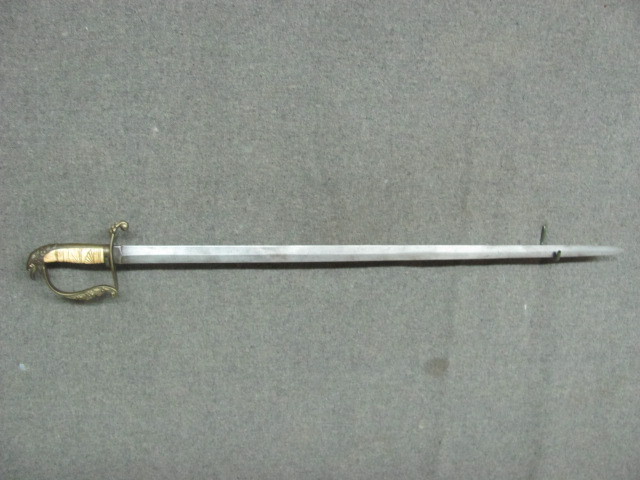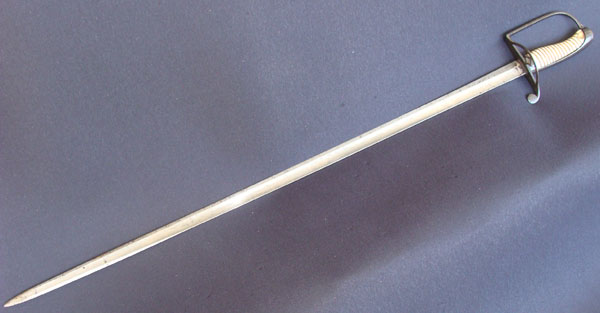Is the only correct definition for "broadsword" the usual basket-hilted broadsword, or are there broadswords without basket-hilts? I've heard of the "Norman broadsword" and the "archer's broadsword", which are usually just arming swords with simple cruciform hilts, long-ish grips and exceptionally wide blades. Are there any historical examples of these types of swords, and are they ever classified as broadswords? Does a broadsword have to have a certain shape of blade to be a true broadsword? I've wondered this for a long time.
Hi Wesley
Broadsword is really a modern term that is used to describe a number of genre and types pf swords. I wouldn't get hung up on the term but rather look at the Oakeshott series of feature articles here at myArmoury.
http://www.myArmoury.com/features.html
It is generally easier to look at the Oakeshott classifications to determine a sword from the medieval period from the NOrman conquest up to the renaissance period. Then you have both earlier periods and later periods with their own jargon and classifications.
The basket hilts get labeled as broadswords or backswords to define whether there is a single edge or two. This holds sway even into the 19th century to differentiate between a spadroon or broadsword.blade. Both of these latter are actually quite slim blades in comparison to a broad medieval type.
My 1850s eagle pommel is an example of a late British broadsword blade. Then compare that to a backsword or spadroon. To confuse things further, many swords will be labeled as cut&thrust ;) That, perhaps to lead that such are narrower pointy things but still have a working edge.
Cheers
GC
 Attachment: 73.56 KB
Attachment: 73.56 KB

 Attachment: 44.3 KB
Attachment: 44.3 KB

Broadsword is really a modern term that is used to describe a number of genre and types pf swords. I wouldn't get hung up on the term but rather look at the Oakeshott series of feature articles here at myArmoury.
http://www.myArmoury.com/features.html
It is generally easier to look at the Oakeshott classifications to determine a sword from the medieval period from the NOrman conquest up to the renaissance period. Then you have both earlier periods and later periods with their own jargon and classifications.
The basket hilts get labeled as broadswords or backswords to define whether there is a single edge or two. This holds sway even into the 19th century to differentiate between a spadroon or broadsword.blade. Both of these latter are actually quite slim blades in comparison to a broad medieval type.
My 1850s eagle pommel is an example of a late British broadsword blade. Then compare that to a backsword or spadroon. To confuse things further, many swords will be labeled as cut&thrust ;) That, perhaps to lead that such are narrower pointy things but still have a working edge.
Cheers
GC


Like Glen says, "broadsword" is a modern and somewhat vague term. Though, if we define it in this particular context as "Renaissance or post-Renaissance era cavalry-type cut-and-thrust sword", I would say there are indeed a few type of blades that falls in that category without having a basket hilt:
This sword is refered to as a "Venetian Broadsword" in the albums:
[ Linked Image ]
And in this photo, I might consider the one between the rapier and the katzbalger to be of this type as well:
[ Linked Image ]
As I understand it, the blades used for broadswords of the time were mostly manufactured in one place like for example Solingen, then exported to other countries where they were hilted locally. So it wouldn't surprise me of this type of blade shows up on a few non-baskethilted swords.
This sword is refered to as a "Venetian Broadsword" in the albums:
[ Linked Image ]
And in this photo, I might consider the one between the rapier and the katzbalger to be of this type as well:
[ Linked Image ]
As I understand it, the blades used for broadswords of the time were mostly manufactured in one place like for example Solingen, then exported to other countries where they were hilted locally. So it wouldn't surprise me of this type of blade shows up on a few non-baskethilted swords.
Hmm...I probably would have thought the sword in the second picture was some kind of side sword, but I can't see the tip - is it more broadsword-ish, or cut and thrust-ish? A for the one in the first picture, that actually really looks like a schiavona with the basket hilt removed or something. What are the usual characteristics of a Venetian broadsword?
so is a broadsword just a sword with two complete edges?
| Ryan S. wrote: |
| so is a broadsword just a sword with two complete edges? |
Well, you couldn't call a rapier a broadsword. Rapiers are double edged. So are longswords, bastard swords, zweihänders, jians, and many others that couldn't be classified as broadswords. Look up "Scottish basket-hilt broadsword" on Google. Im pretty sure that blade shape is what makes a sword a broadsword.
In the period when the term was invented there were mostly rapiers, smallswords, backswords and broadswords. Longsword and two hander was rarely used by that time. So it was basically double edged sword broader than smallsword or rapier.
| Wesley Nilsen wrote: |
| Hmm...I probably would have thought the sword in the second picture was some kind of side sword, but I can't see the tip - is it more broadsword-ish, or cut and thrust-ish? |
A broadsword is a cut and thrust sword, pretty much. They are not very specific terms; any sword that is designed for both cutting and thrusting is a cut and thrust, pretty much. (Though, it mostly applies to swords from the Renaissance and later.)
I wouldn't consider it a sidesword mostly because it doesn't appear to have a dedicated ricasso and thus would probably be wielded closer to how you would handle a baskethilt. I'm just theorizing, though - I don't actually know anything about the sword in question.
| Quote: |
| A for the one in the first picture, that actually really looks like a schiavona with the basket hilt removed or something. What are the usual characteristics of a Venetian broadsword? |
I don't think there's any specific defintion of the term. It's a broadsword from Venice, pretty much. It might very well be a schiavona-type blade - like I said, the blades varied a lot less than the hilts.
That was pretty much what you were asking about, after all: Swords with baskethilt type blades but without the baskethilt.
| Luka Borscak wrote: |
| In the period when the term was invented there were mostly rapiers, smallswords, backswords and broadswords. Longsword and two hander was rarely used by that time. So it was basically double edged sword broader than smallsword or rapier. |
Pretty much. These terms are very contextual - you only need a term like "broadsword" to describe swords broader than the standard, just like you only need a term like "cut and thrust sword" when most regular swords are specialized thrusters.
In medieval times, when basically all swords were broad cut-and-thrust swords, they were just called "swords."
Page 1 of 1
You cannot post new topics in this forumYou cannot reply to topics in this forum
You cannot edit your posts in this forum
You cannot delete your posts in this forum
You cannot vote in polls in this forum
You cannot attach files in this forum
You can download files in this forum
All contents © Copyright 2003-2006 myArmoury.com — All rights reserved
Discussion forums powered by phpBB © The phpBB Group
Switch to the Full-featured Version of the forum
Discussion forums powered by phpBB © The phpBB Group
Switch to the Full-featured Version of the forum